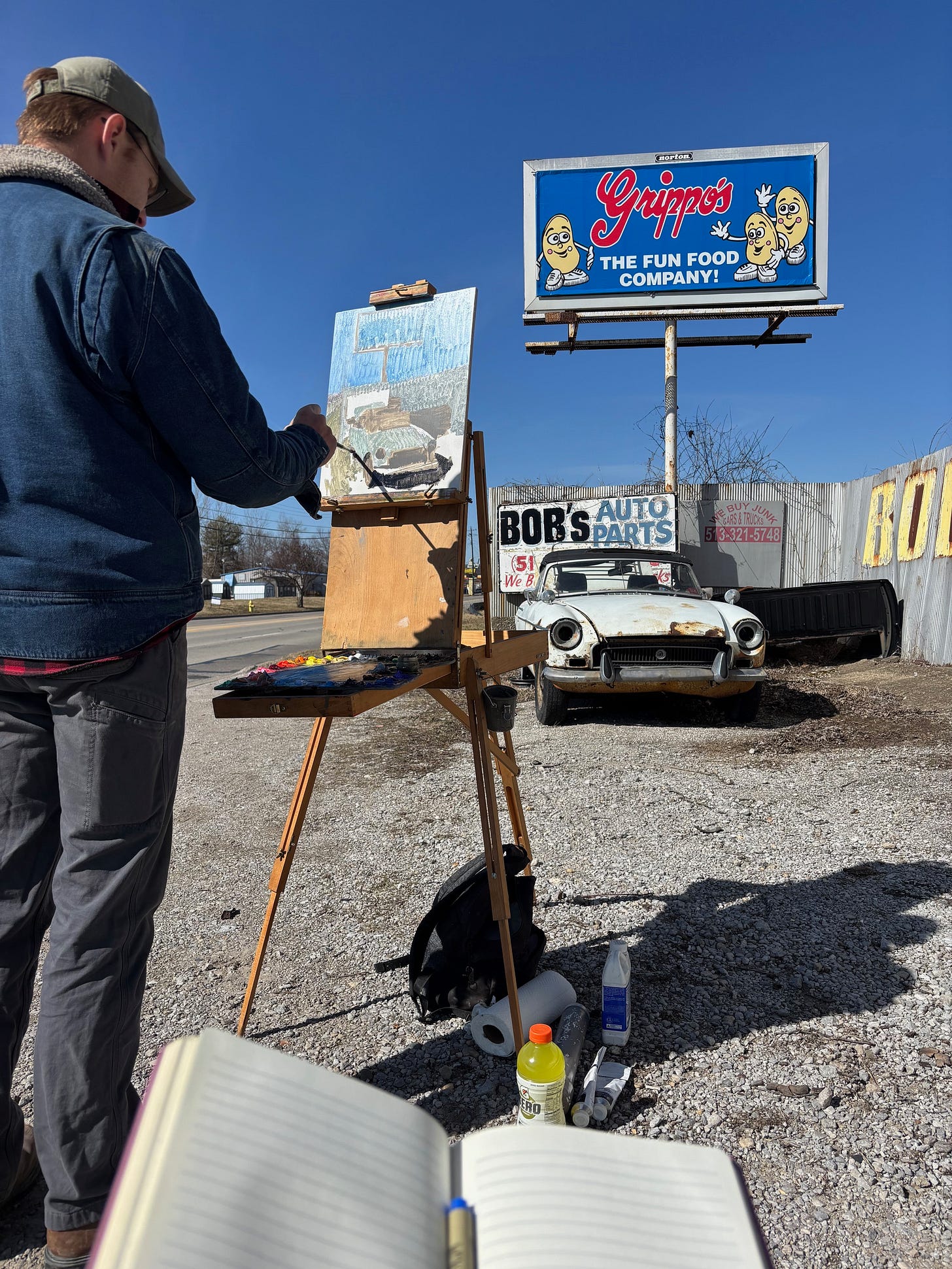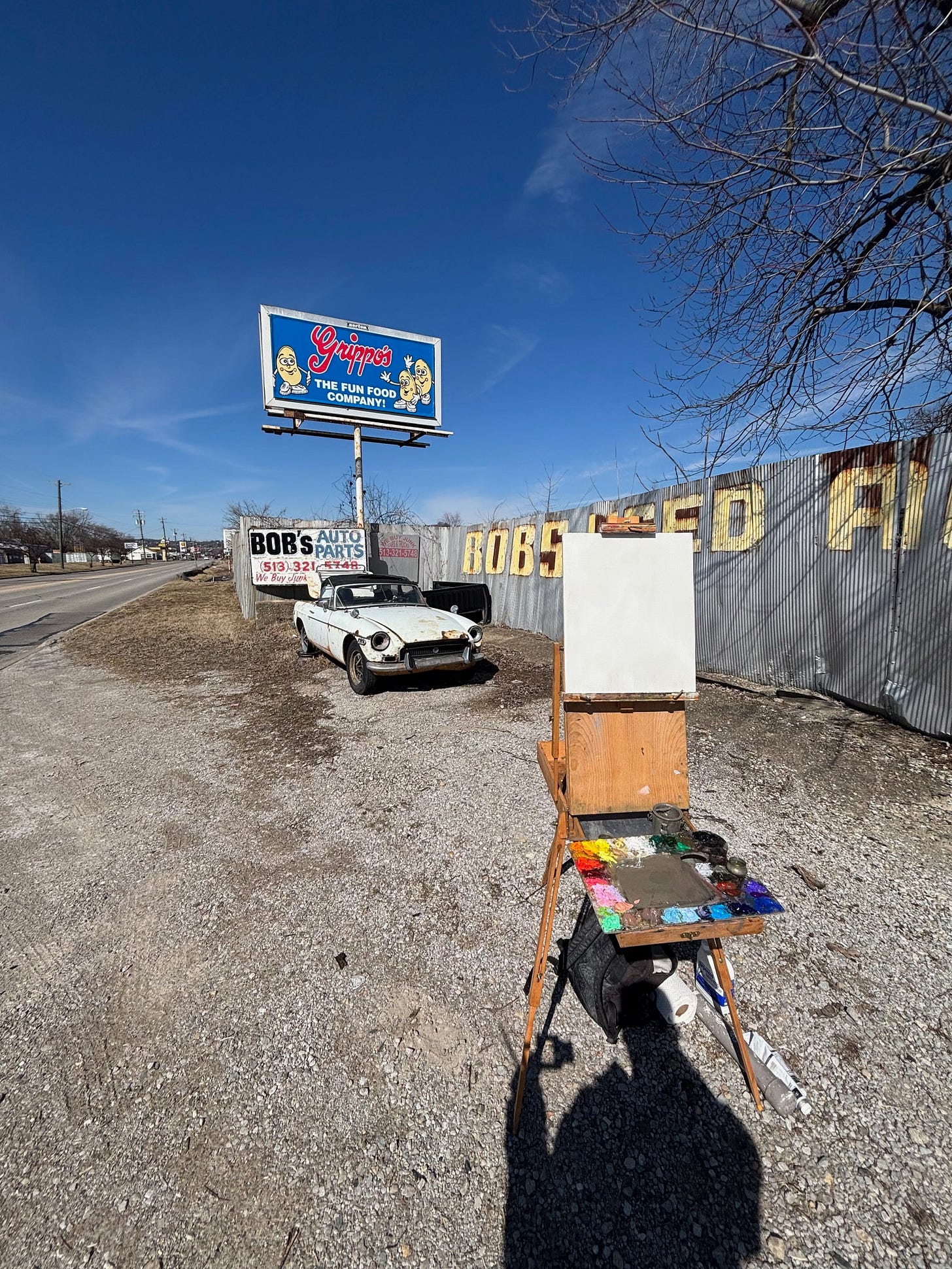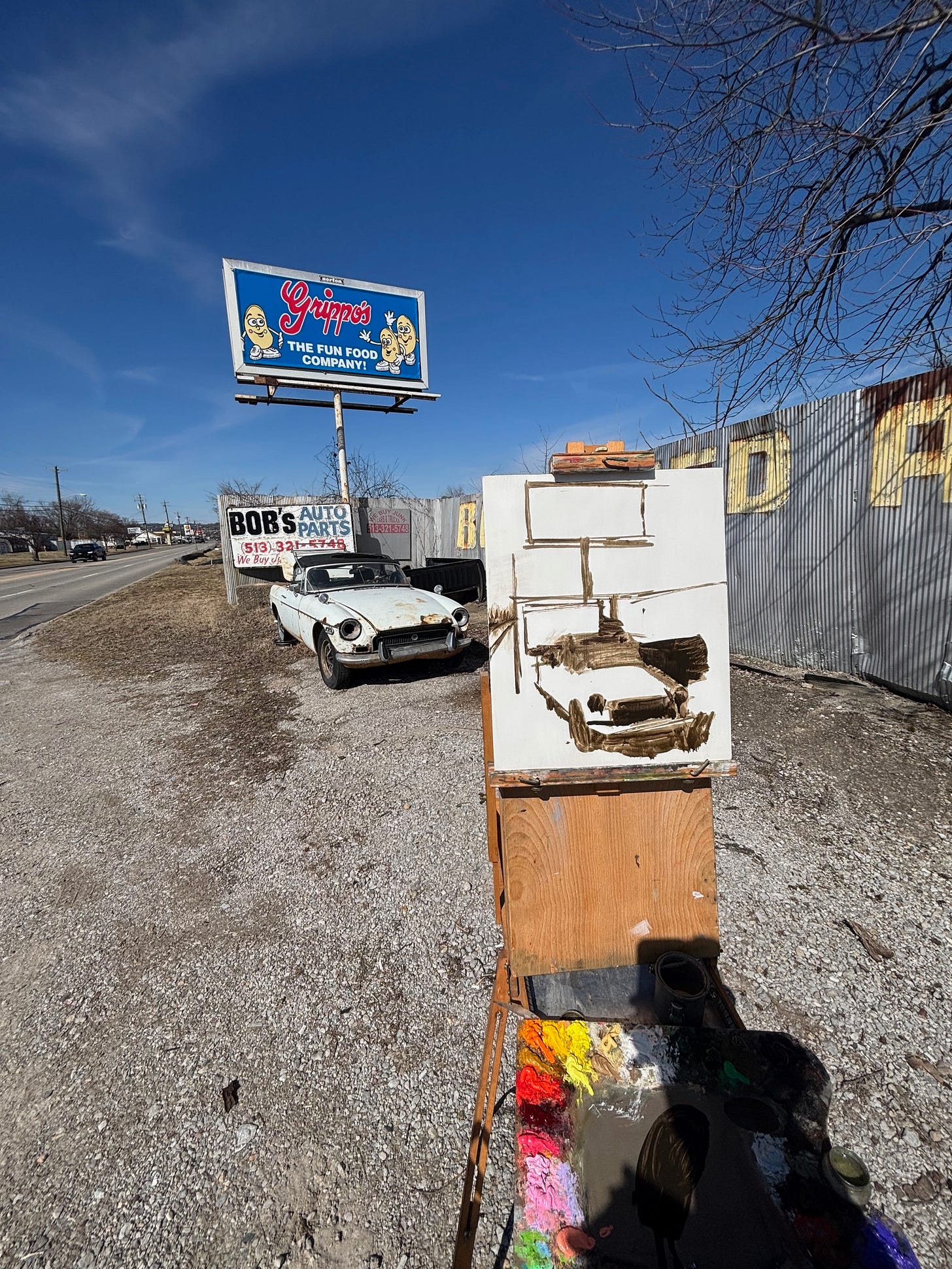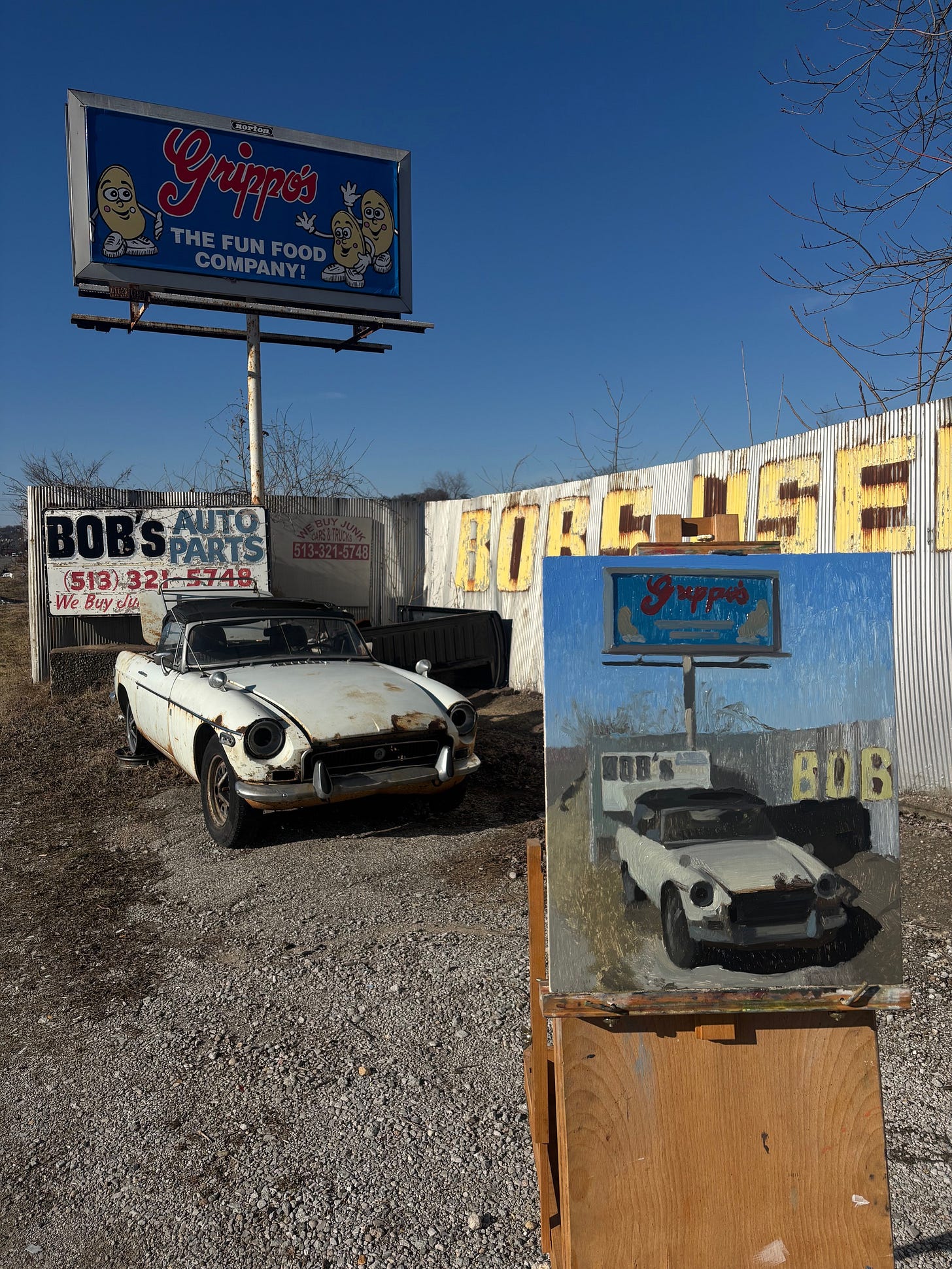Bob's Auto Parts (An Introduction)
Bob's Used Auto Parts, Kellog Avenue, Cincinnati, OH / March 2, 2025
Brad is painting a 1960s baby blue MG Midget—he says it’s not really baby blue; that’s just primer. At some point someone sandblasted the whole antique thing down to bare metal and primed it for paint, but never got around to it. The car is in front of a rusty corrugated metal fence that says Bob’s Used Auto Parts in peeling yellow paint. Above us there’s a Grippo’s Potato Chip sign that’s made to look vintage— little potato chip people with shoes on and big smiles standing over the words “The Fun Food Company.”
There’s not much room in this gravel pull off before the junkyard gate, so we left our cars in a parking lot down the road. There are no sidewalks on this stretch of Kellog Avenue, so we walked through the dry winter grass— Brad carrying his French easel and backpack and me with my camp chair and a UDF bag holding my notebook, a water bottle, and a Gatorade for Brad.
Two men in trucks have pulled off to look at Brad’s painting—one took a picture and one asked if Brad could paint a mural of a frozen creek bed on his living room floor and polyurethane over it so it’s like walking on ice. A big group of cyclists just passed us; the soft, bright hiss of their wheels so different than the sharp whoosh of passing cars. Across from us is a fenced-in lot with prefabricated garden sheds and greenhouses.
It’s sunny today and cold. Brad steps back and forth in the gravel as he paints, looking at his work from different angles. It’s so bright, I’m thinking of grabbing my sunglasses from the car. Squinting into the light, my left hand holding my journal, I notice a shimmer on the pages. At first I think it’s a reflection from my zipper or water bottle, but I realize the diamond on my engagement ring is refracting the sunlight in an arc.
There’s a cheesy (but true) metaphor in this— Brad’s love, our marriage and life together, has brought so much light to my life and my writing. Being out here with him, or working on my novel at the desk in our studio while he paints, has truly changed the way I write. I’ve been camping and fishing in Kentucky with my family since I was young, and my undergraduate degree in Outdoor Education had me spend a lot of time backpacking and canoeing; I’ve spent a lot of quiet time in nature. But sitting still, in the same spot, for a few hours while Brad paints something—a tree, a bridge, or an old car—has changed how I see the world.
I used to write almost exclusively on my computer or phone—I liked the cleanness of black digital text on a white screen, and I wanted to get my thoughts down quickly. But watching Brad’s patience in the ancient art of “pushing colored mud around on a surface” (as he describes painting), has given me an appreciation for the tactility of writing, of making marks on a blank page in response to my surroundings, of physically changing the world in this small way.
I remember one of the first times I sat with Brad for a whole plein air painting. We were at General James Taylor Park in Newport Kentucky, looking out over the Ohio River and the Cincinnati skyline at night. The whole time he was painting—a couple of hours at least— we talked about art and beauty and God, about feeling a bit like an outside observer, and wondering if that’s the role of every artist. I got nervous I was talking too much, distracting him from his work. He said it was great to have me there, that talking with me and listening was like hearing a really good podcast. We were just friends then, still getting to know each other, but I knew that he was a building a life I wanted to be a part of.
Before we met, Brad and I both read “Letters to a Young Poet,” and we return to Rilke’s words often. This brilliant poet (who worked as a studio assistant for the sculptor Rodin) says, “the highest form of love is to be the protector of another person's solitude.” I experienced that type of love growing up from my parents; I felt so loved for who I was, and so protected—they wanted me to flourish as the unique person I am, even when they didn’t understand it. And I’ve found that love with Brad—I want to protect his solitude, to make space for him to be himself and make the art that only he can make, and I know he feels the same about me.
When we were “just friends,” Brad told me he wasn’t sure if he’d ever love anyone as much as he loves painting. Before our wedding last summer I reminded him of that and asked him what changed. “You are painting,” he said. “Our love is our art.”
In the gravel lot, Brad steps back from his painting and says he’s been hearing a mourning dove between traffic sounds. I haven’t heard it, but I’m listening. I hear some other birds chirping at intervals and an engine from Lunken Airport, where private planes are landing and taking off. I grew up just across the river—I can see the Kentucky hills back behind the parking lot with the prefab sheds. From a few spots in my town, you can look across the river, over to Lunken and watch the planes roll around like children’s toys. As a kid I’d ride my bike to the overlooks; I loved watching the plane lights at night, and the streetlights like a jeweled necklace following the river.
I never could have imagined, all those years ago, that one day I’d be sitting along that distant highway in my parent’s University of Kentucky camp chair writing, while my husband, the love of my life, paints an antique car in front of a junk yard.
Check out Brad’s process photos below. He wants to spend some more time on this one, so he’s going to go back another sunny day this week to finish up.
Want some Plein Air Poetry in your physical mailbox? Grab a book or print from our online shop!












I loved this story, the writing of art always infused with people, their interactions and their actions together. I don’t know the places at all (I am in Northern England -UK) but I kind of ‘know’ that perfect scene, feel it anyway. It’s magnificent, a great spot by you guys. Good luck in all you do, it’s so perfect to see visual and lyrical so entwined. I’m writing a nove under a flyover - which it turns out is actually a viaduct because it crosses a river not a road, but that does not sound anywhere near as cool as Flyover Gallery! Thanks for sharing, I’m in a fog with a chapter on my knee, Substack popped up, I chased a few links and bingo - here I am! Thanks and best wishes, Peter
This doesn’t feel like writing. It feels like witnessing.
There’s a stillness to it—not the kind you force, but the kind you earn by being there long enough. You’re not rushing to capture meaning—you’re letting it accumulate. The gravel, the trucks, the chip sign, the ring light on the page—it’s all quiet and unremarkable until you put it through your lens. And then suddenly, it’s sacred.
The relationship at the center doesn’t feel idealized—it feels used, in the best way. Like something lived in, tested, repurposed into art. That “you are painting” line could be cheesy in the wrong hands, but here it’s just… true. Not because of how it’s said, but because of everything around it.
Also, the metaphor isn’t just emotional—it’s physical. Watching Brad move, listening to traffic and doves, putting pen to paper instead of screen—it’s about letting the world shape you instead of trying to control it. That’s what makes it hit different than a romantic essay or a painter’s journal.
Nothing in this is reaching. And that’s rare.